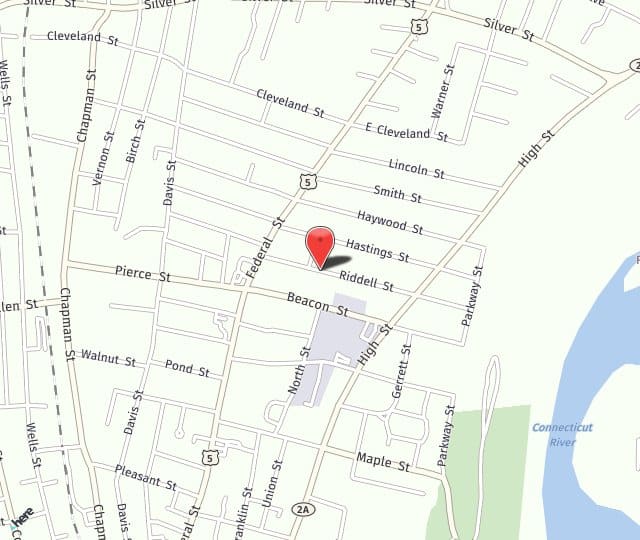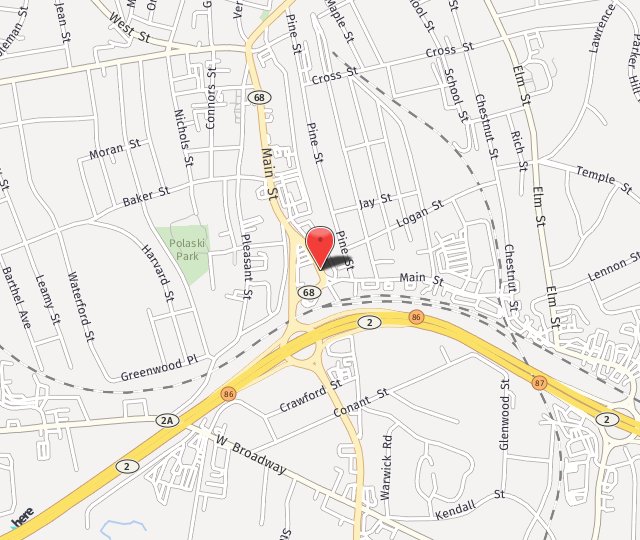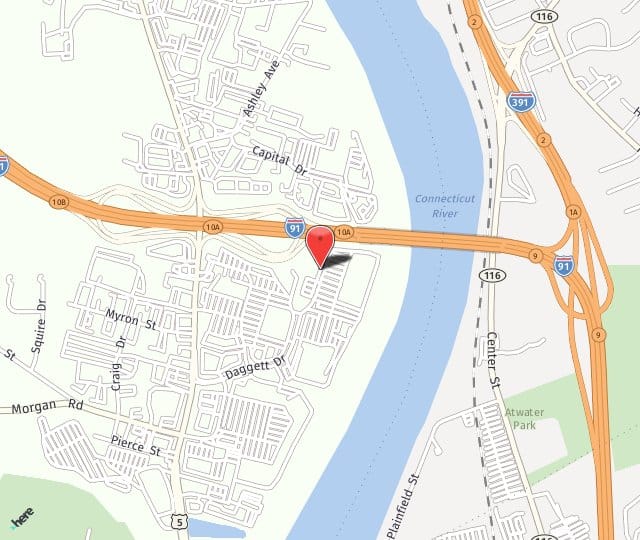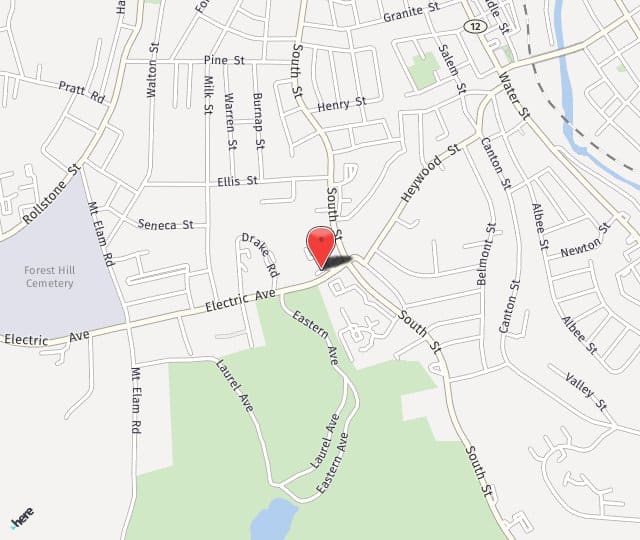
Tired of the hassle of glasses and contact lenses? LASIK surgery or Advanced Surface Ablation (ASA) may be your solution. You don’t have to deal with the discomfort of foggy glasses, gritty contacts, and red, irritated eyes for the rest of your life.
Longwood Eye & LASIK Center is a trusted name in eye care. Our
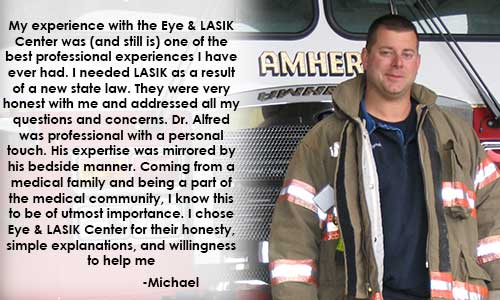
What Is LASIK Eye Surgery?
LASIK, which stands for Laser-Assisted In-Situ Keratomileusis, is a popular way to permanently correct vision problems like nearsightedness, farsightedness, and astigmatism.
During the procedure, your surgeon creates a thin flap on the surface of your eye and then gently reshapes your cornea using a laser. This reshaping corrects how your eye focuses light, improving your vision.
Many people choose LASIK because of its quick recovery time and minimal discomfort. In most cases, patients achieve 20/20 vision and can return to their normal activities very quickly.
LASIK Surgery Recovery
Many patients experience major improvement in their vision within the first few days after the procedure, often finding they can drive and return to work within one to three days. Most people notice clearer vision as early as the day after surgery, but recovery times can vary depending on individual healing patterns. Post-surgery, there are only a few activity restrictions, which we’ll go over in detail before your procedure.
Advanced Surface Ablation (ASA)
Advanced Surface Ablation (ASA) is another laser procedure for vision correction, but it works a bit differently than LASIK. Instead of creating a flap, ASA treats the surface of the cornea directly. The same laser is used to reshape the cornea and correct your vision.
ASA is often recommended for people with thin corneas or surface irregularities that make them less suitable for LASIK.
ASA Recovery
After ASA, the surface cells of the cornea start to heal right away and typically take about three to five days to fully regenerate. Vision recovery with ASA is more gradual than with LASIK, and most people can get back to their normal routines within five to seven days.
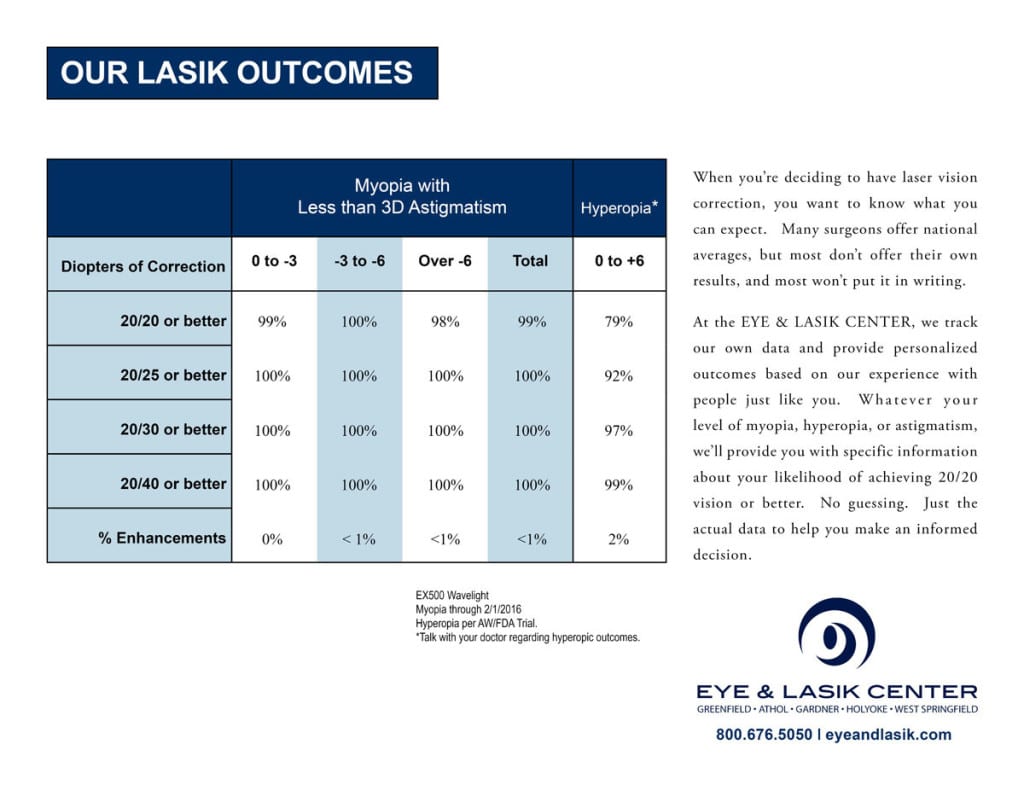
LASIK Results
We base your expected results on real data from real patients. Whether you’re nearsighted, farsighted, or have astigmatism, we’ll give you clear, personalized information about your chances of achieving 20/20 vision or better after your LASIK surgery.
While LASIK permanently changes the shape of your cornea and improves how your eye focuses light, it doesn’t prevent age-related issues like presbyopia (the need for reading glasses) or cataracts. These conditions will still need to be treated separately as you age.
Am I a Candidate For LASIK Surgery?
LASIK does a great job correcting fixed focus imperfections of the eye (nearsightedness, farsightedness, astigmatism). You will likely do very well with LASIK if you meet the following criteria:
- Between the ages of 20 and 55
- Have nearsightedness up to about -9.00, with or without astigmatism up to about -5.00
- Have corneas of normal thickness and curvature
- Do not have keratoconus or some other corneal pathology
- Are in generally good medical health
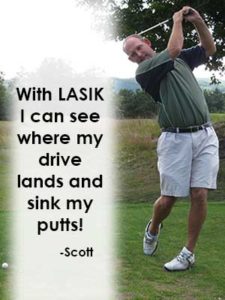
The only way to know for sure if you’re a candidate for LASIK is to see us for a LASIK consultation. This visit is free and lasts about one hour. We’ll take several measurements to determine if LASIK is a good fit for you. We’ll also let you know if you’re likely to achieve 20/20 vision with the procedure.
Reviews From Our Clients!
Benefits of Vision Correction Surgery (LASIK and ASA)
LASIK and ASA can offer the following life-changing benefits that make daily life easier and more enjoyable:
- Freedom from glasses and contacts: Enjoy everyday activities without needing corrective eyewear.
- Improved vision: Many patients achieve 20/20 vision or better after surgery.
- Quick and minimally invasive: Both LASIK and ASA are fast procedures with minimal discomfort.
- Fast recovery: LASIK patients often return to normal activities the next day; ASA patients typically recover within a week.
- Long-lasting results: These surgeries can reduce or eliminate the need for vision correction for many years.
What to Expect on Surgery Day
Expect to be in our office for one to two hours total. The surgery itself can take as little as ten minutes per eye. Shortly after you arrive, we’ll give you numbing drops in your eyes (there are no needles involved). We can also offer you something to help you relax if you’re feeling anxious.
You’ll be awake during the procedure, but you won’t feel any pain. When the surgery begins, you’ll be asked to focus on a target light while the laser reshapes your cornea. You might feel slight pressure on your eye, but the process is quick and generally painless.
After the procedure, your vision may be blurry, so you’ll need someone to drive you home. Most patients find they can return to their normal activities as soon as the next day.
Why Choose Longwood Eye & Lasik Center?
Our team at Longwood Eye & Lasik Center consists of highly skilled ophthalmologists and optometrists. Whether you're seeking routine eye exams, glaucoma treatment, or advanced LASIK surgery, we are here to meet your vision needs with the highest standards of care. We offer more than just medical expertise; we provide a warm, welcoming environment where you can feel confident about your eye healthcare.
Our experienced surgeons, including Dr. John Warren, Dr. Aaron Fay, Dr. Howard Ying, Dr. David Lotufo, Dr. Cris Martin Jacoba, and Dr. Vamsee Neerukonda, utilize the latest techniques and technology to get outstanding results. From LASIK and cataract surgeries to specialized treatments for retina and glaucoma conditions, we handle a wide range of vision challenges. Our goal is to offer superior outcomes while providing personalized care that makes you feel valued.
Frequently Asked Questions (FAQs)
How Can I Prepare for Treatment?
Here are a few simple steps you can take to prepare for your LASIK or ASA treatment:
- Wear your glasses: Bring your most current pair of glasses with you. If you wear contact lenses, please stop wearing them before your appointment as instructed. This helps ensure accurate measurements for your surgery.
- Relatively short visit: Plan on being at our office for one to two hours.
- Bring your calendar: You may find it helpful to bring your appointment calendar with you for convenient scheduling.
- Arrange for a ride home: You will need somebody to drive you home after surgery, so make sure to plan ahead for that.
Does LASIK Hurt?
There is little or no discomfort during the procedure. We also use eye drops to numb the eyes. No needles or injections are required. After LASIK, post-operative discomfort is minimal.
Can I Wear Contacts After LASIK Surgery?
Yes, you can wear contacts after LASIK surgery, but it is very unlikely you would need to. Our laser system, the WaveLight® EX500, is the fastest and most accurate LASIK laser system on the market and is designed and proven to deliver better vision than what you can achieve with contact lenses or glasses. Some patients need corrections for certain part-time or specialty activities. They usually choose glasses in these situations.
Is LASIK Safe?
We understand that your vision is incredibly important, which is why we use the Allegretto Wave technology, one of the safest and most precise LASIK lasers available today.
Are There Any Risks Associated With LASIK?
No surgical procedure is without risks. Serious complications are rare, occurring in less than 1% of cases. Our doctors will thoroughly discuss the potential risks and benefits with you so you have all the information you need to make a decision.
How Much Does LASIK Cost?
At Longwood Eye & LASIK Center, LASIK surgery costs $1,500 per eye<. There are no hidden fees, and the price doesn’t change based on your prescription or level of astigmatism — everyone pays the same flat rate. We also offer financing options through CareCredit, allowing you to make affordable monthly payments.
Schedule a Consultation
If you are interested in learning more about LASIK surgery and would like to find out if you are a good candidate, please call 1-855-286-2020 or request a consultation online.

